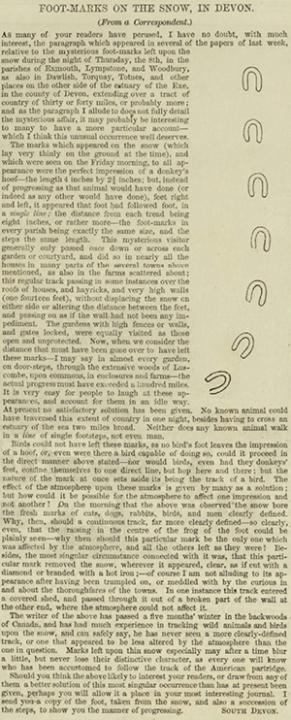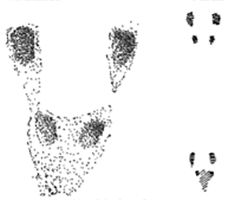
| Added | Wed, 04/01/2017 |
| Источники | «Охота и охотничье хозяйство» № 03 - 1987 г.
|
| Феномены |
The best-known case of the emergence of copytophone traces considered incident under the title "traces of the Devil in Devon", which occurred in February 1855 around the axe estuary in South Devon. There are a huge number of scientific and mystical hypotheses explaining the causes of these marks – from jumping mice and kangaroos to the mysterious creature called spring-heeled Jack. They are all described in detail in the review article "the Phenomenon of the devil's footprints".
Here we suggest another hypothesis for this case.
Case description
The earliest documentary evidence of this case, which managed to find is article in the Times newspaper dated 16 Feb 1855
In this note described the unusual tracks, which saw residents of several towns in South Devon in the morning after a heavy snowfall. Tracks like "imprint of the hoof of a donkey" in size from one half to two and a half inches, was discovered everywhere: not only in the fields and in the courts, but also on the roofs and walls of houses. Omnipresent entity even approached the doors of several houses, but then retreated. The local priest in the sermon suggested that these traces are left by a kangaroo, but this idea was rejected because traces were found on both sides of the estuary of the Ex – it is unlikely that a kangaroo could get to the other side of the river.
In a short note published in that newspaper on March 6, 1855, mentioned that the locals were trying to arrange a RAID on the unknown creature, armed with rifles, but was unable to detect it.
Information about the same event in articles published in another newspaper, the Illustrated London News, 24 Feb 1855, had significant differences.
So, according to this publication, the footprint size was 4 by 2 2/3 inches, and most unusual in the traces was that, even though they were located on one line, but the distance between them was large enough: a mysterious creature has left only one trail in most of the visited households. In this case, as in the Times articles reported that footprints were found on rooftops, haystacks, and even on the wall – one of them was a height of 14 feet. In this same article, it is the first sketch of the residue.
Hypothesis
If you compare the hoof prints in Devon with traces that are left in the ground and the snow are different beasts, the greatest similarity they have with squirrel tracks.
The traces of four paws flying squirrels to jumping into the soft snow . Fingerprints much less than the whites, jumping in short. Kostroma oblast. [1]
Traces of flying squirrels is very similar to squirrel, but smaller. They also differ in the location of the individual prints: from the flying squirrels ahead are the tracks of the front paws, and a squirrel on the contrary – the prints of the hind feet are ahead of the front. But she and another form form a "hoof". The dimensions of this imprint can be from 10 to 12 cm in length and 7.5-8 cm in width. They usually have more pronounced fingerprints, but we've got to compare the fingerprints left it in loose snow, because in this case, in the night, the snow fell. The distance between the footprints Bouncing proteins is usually from 20 to 45 cm.
The usual cause of displacement of animals from place to place is the lack of food, but movement may also be associated with fires, massive deforestation, or other causes that put the life of the animal danger.
Protein migration can take place any time of year, but most often in late summer and autumn, and can last about 6 months. Proteins sometimes overcome the distance of 500 km or more. Wandering squirrels are the broad front (sometimes up to 300 km) alone without forming substantial flocks and clusters, except for natural obstacles. During migration, the squirrels go into the forest-tundra and tundra appear in the steppe regions, across rivers and bays penetrate on the island, across the bare tops of the mountains come even to the settlements, overcoming any obstacles. [1, 3, 4, 5, 7 ]
Thus, the traces discovered in South Devon in February 1855, it could be left migrating proteins.
Conclusion
Given the area of distribution of a protein [3], this hypothesis seems quite probable. In addition, the population of squirrels in those years was much higher than it is now (its reduction caused by deforestation in the eighteenth and nineteenth centuries). So in those conditions the probability of a delayed migration of a few individuals, it seems quite possible.
Undoubtedly, this is only a hypothesis trying to explain the old case. For some definitive data is scarce.
Translated by «Yandex.Translator»
Log in or register to post comments




